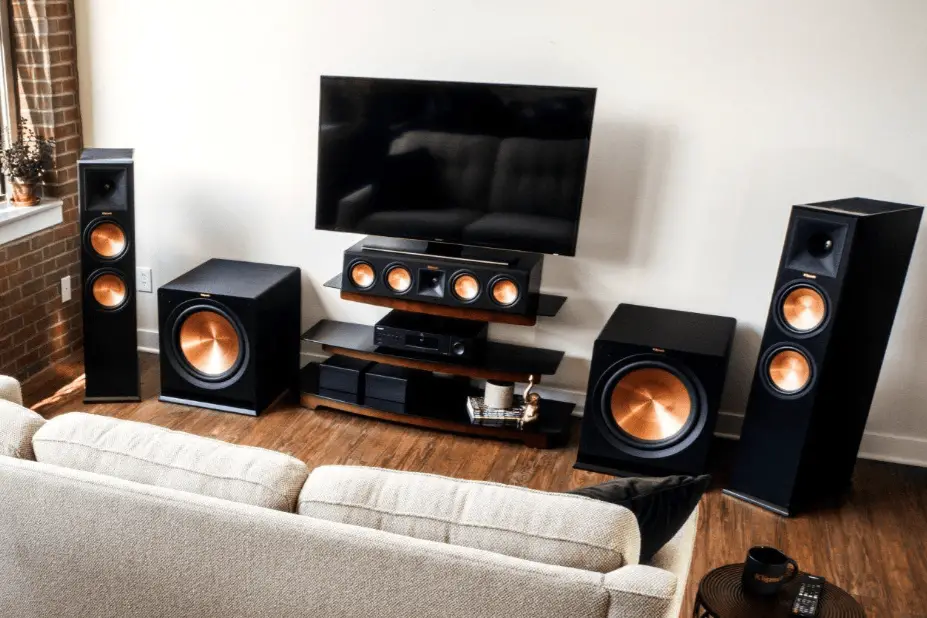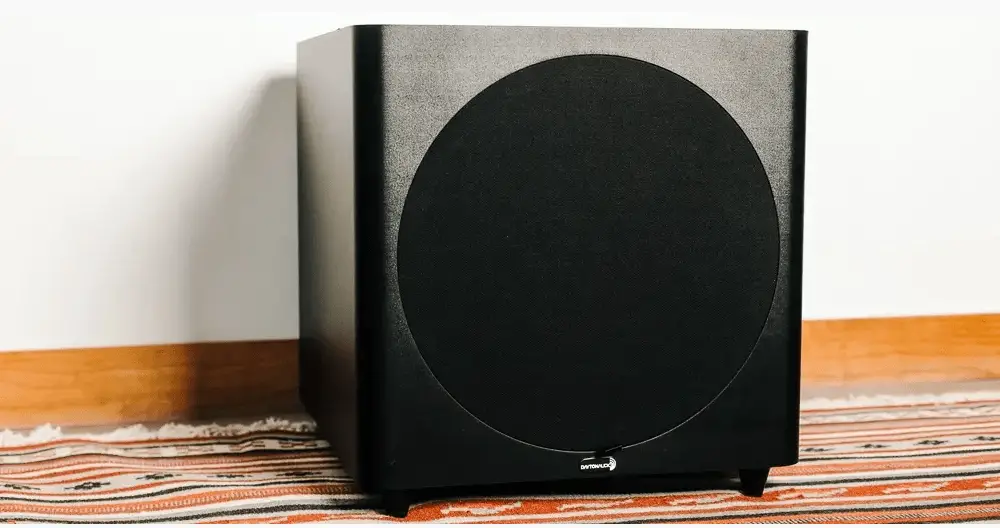People who used to live in small apartments are more likely to give up on owning a subwoofer because of the small rooms, so the group’s collective needs frequently outweigh the desires of the individual. They do not buy a Sub because they believe that the music will also blast up to their neighbors and will disturb them.
But do you know that adding the right subwoofer for your space needs can actually help to reduce average listening levels while creating a vibrant, deeper overall sound without bothering your neighbors?
This article will explain why a subwoofer is necessary and where to place it in a small room. Because if you can appropriately place a subwoofer in the room, you should have a much flatter bass response.
Is A Subwoofer Required In A Small Room?
Yes, a subwoofer is probably a must-have for a small room because it blends so well with the main speakers and provides deeper Bass. You can almost feel the couch massage you while you play the sub. The bass response should be much flatter if the subwoofer is appropriately placed in the room.
As a considerate individual, a sealed subwoofer for a small room is used to provide a more positive response. So, you could go with a pair of 12 inch sealed subs, which can sound bottom-heavy in a small room due to the lower frequency room gain.
A subwoofer will not provide deeper and more settled Bass in a small untreated room where it won’t be audible because it will sound strange in this room.
As a result, proper treatment of your small room is required, which includes removing reflections, standing waves, dampening all of the walls, and installing a multitude of Bass Traps.
In a small room, treatment can begin with installing homemade fiberglass traps on all of the walls and ensuring that no parallel walls have untreated facing spaces.
In addition, install fiberglass panels on the ceiling and thick foam underlayment and carpet from wall to wall on the floor.
Because carpet only helps with high frequencies, which are the only ones you can easily hear until you get used to listening to midrange blurring, it is only useful for high frequencies. So fiberglass traps are better.
Install a 6 inch or deeper fiberglass Bass Trap in each corner from the ceiling to the floor for better sounds. Strong cloth bags of fiberglass insulation can be hung on the doors to serve as moveable Bass Traps.
After you’ve completed all of the repairs, you can add a subwoofer, but keep it out of corners and away from symmetrical positions within the room to increase sub output, causing the sub to become louder. A foot away from a sidewall and not evenly between the two end walls is a good place to start.
Because subs become blurred by room reflections, there would be a significant difference in Bass and sound mixing between treated and untreated rooms. So keep your subwoofer in a treated small room for better Bass and acoustics.
How To Get Good Bass In A Small Room?
If you are looking for good bass performance in a small room, you should choose a subwoofer that is appropriate for the size of the room. Also, consider the power output and the frequency range as well. The goal here is to have the best Bass for you, not the cleanest Bass.
This section will go over a few things to think about when it comes to Bass in small spaces.
1- The lowest frequency room resonances for the small room dimensions are irritating. To remedy this, replace the subwoofer location and seating proportion; this will undoubtedly help to reduce resonances in the small room and improve music quality.
2- Room gain in a small room is more significant and makes the musical Bass much better due to Bass Traps and the fixings mentioned above.
3- Distance yourself from your sub in the small room because they are designed so you would get the best sound at a greater length.
4- Smaller rooms are more rigid and airtight, so fewer openings, smaller or stiffer walls or floor or ceiling can help the Bass.
Where Should A Sub Be Placed In A Small Room?
A subwoofer must be placed in the corner of small rooms to increase the subwoofer’s output, resulting in a much better sounding bass.
A subwoofer placed near a flat wall, on the other hand, can produce a rough and unpleasant sound. A sealed subwoofer may work better in small rooms, but if your subwoofer is ported, keep it 6-12 inches away from the wall to allow airflow out of the port.
Assuming the room is approximately 11ft X 8ft X 11ft, the strategy for fixing the room would be to place the speakers 35″ from the front wall and the subwoofer 22″ from the room sidewalls. You can sit 1 inch away from the back wall. As a result, the sound would improve.
What Size Sub Should I Get For A Small Room To Listen To Music?
The size of your room determines the size of the subwoofer required. The subwoofer you purchase should be powerful enough to fill your room with Bass on its own. You don’t need that much power if your room is small.
A small subwoofer will suffice in a small room, but if your room has an open window to the rest of the house, you’ll need more power or a larger sub because the bass sound will need to fill the entire space.
Do I Need 2 Subs In A Small Room?
Yes, you can fit another subwoofer into your small space. It will improve the room’s bass response. Bass waves will bounce around in a small space, interacting with one another. Even in a small room, having two subwoofers can increase the Bass significantly.
Two subwoofers can mitigate the ups and downs in the bass frequency response that a single subwoofer can produce. This is especially important in small rooms, as it ensures that the Bass is distributed evenly throughout the space.
Do Small Rooms Have Better Acoustics?
Yes, small rooms have better acoustics than larger ones because of the balanced ratio of width, height, and length, which contributes to reducing low-frequency pressure build-up areas in our small rooms. A sound wave bounces and reflects off most surfaces in a small room as it travels from a sound source.
So, with the room mentioned above treatment and an appropriately managed and placed subwoofer in your room, you can have good deep Bass in the room with a sound spectrum in the audible range.
Is A Sub Box Necessary?
Subwoofers are not supposed to be used without a box as they require an enclosure, either portable or sealed, to balance the frequencies that are emitted from both sides. Using a sub without a box can result in negligible sound.
A subwoofer box can help to contain all of the vibrations generated by the drivers, preventing mechanical damage to the subwoofer. A correctly sized subwoofer box can also provide significant bass extension and reduce sound interference.
Conclusion:
After the debate, it is concluded that a subwoofer has a significant impact on a small room if properly selected and placed in accordance with your room size.
So, in this treated small room having Bass Traps and fiberglass, a subwoofer provides better acoustics, a much better Bass response, and a deeper and more vibrant sound.



